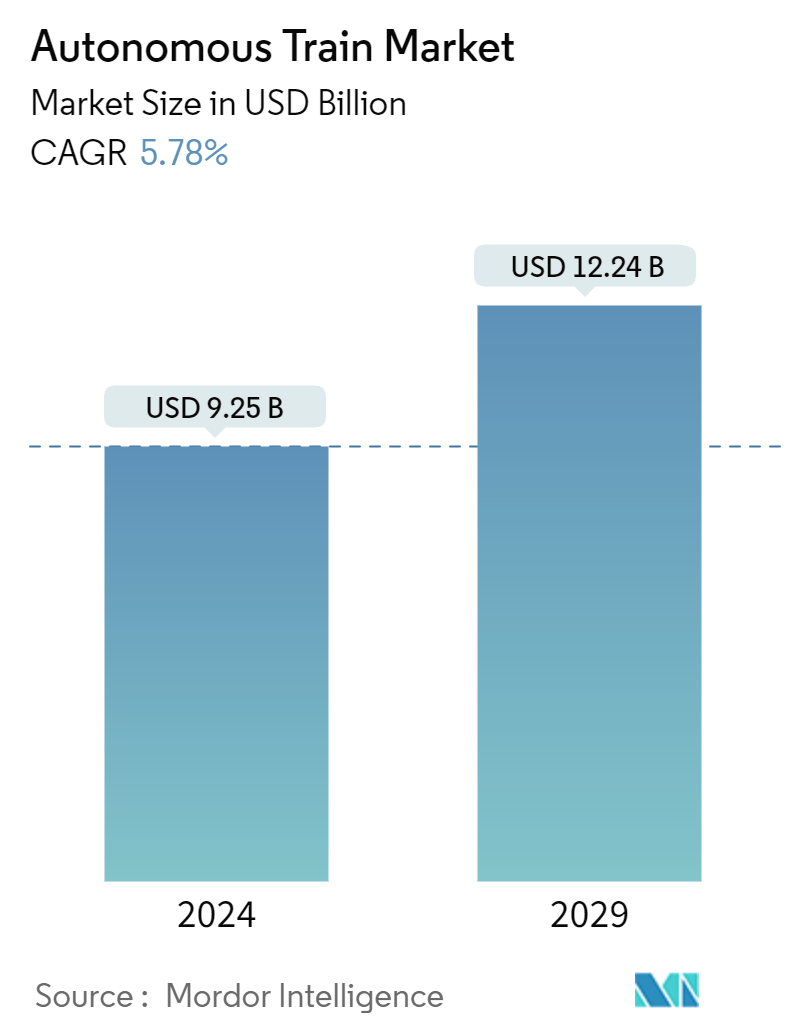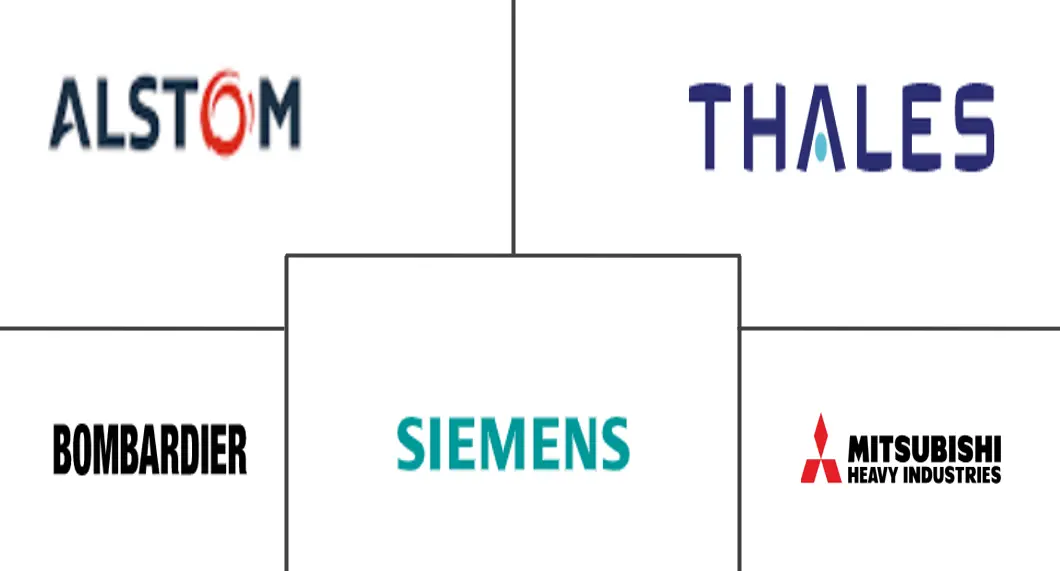Market Size of Autonomous Train Industry

| Study Period | 2019 - 2029 |
| Market Size (2024) | USD 9.25 Billion |
| Market Size (2029) | USD 12.24 Billion |
| CAGR (2024 - 2029) | 5.78 % |
| Fastest Growing Market | Asia-Pacific |
| Largest Market | Asia-Pacific |
| Market Concentration | High |
Major Players
*Disclaimer: Major Players sorted in no particular order |
Autonomous Train Market Analysis
The Autonomous Train Market size is estimated at USD 9.25 billion in 2024, and is expected to reach USD 12.24 billion by 2029, growing at a CAGR of 5.78% during the forecast period (2024-2029).
Over the long term, growing electrification in the transportation sector will likely provide major growth for the autonomous train market. The introduction of the Internet of Things (IoT) in transportation is a major driver for the autonomous train market.
- In March 2023, the SNCF, French national railway, with industry partners, announced the launch of two autonomous trains with integrated technologies, such as artificial intelligence.
- The market’s growth is also attributed to other factors, including the government's focus on increasing railway connectivity and increased focus on replacing older rolling stock with advanced, new-generation rolling stocks.
Economies across the world are investing heavily in railway infrastructure development. Government bodies of several countries worldwide have invested heavily to expand their railway connectivity to cater to growing freight and passenger transportation requirements. For instance, at the end of 2023, the total length of railway tracks in China was 159 thousand km, an increase from 155 thousand km at the end of 2022.
Major governments across developed and developing countries, including China, the United States, and Japan, are investing in connected mobility, which may provide significant growth opportunities for the autonomous train market. Asia-Pacific and North America are expected to dominate the autonomous train market during the forecast period. Asia-Pacific has one of the largest rail networks in the world and is expected to show major growth with upcoming projects in the market. For example,
- In January 2024, CRRC announced its plans to introduce the autonomous train to Indonesia, which is planned to be exhibited at the IKN in July 2024. The Indonesian government has been in talks with China Railway Rolling Stock Corporation (CRRC) to use a set of its autonomous trains for Indonesia's new capital, Nusantara or the IKN.
Considering such factors, the market is expected to witness exponential growth in the future.
Autonomous Train Industry Segmentation
An autonomous train is a driverless train that operates without human intervention. Equipped with advanced technology, such as AI and sensors, it navigates, controls speed, and makes decisions on its own. Benefits include improved efficiency, safety, and capacity. However, safety standards and testing are crucial for public integration.
The autonomous train market is segmented by automation grade, application, technology, train type, and geography. By automation grade, the market is segmented by GoA 1, GoA 2, GoA 3, and GoA 4. By application, the market is segmented by passenger and freight. By technology, the market is segmented by CBTC, ERTMS, ATC, and PTC. By train type, the market is segmented into metro/monorail, light rail, and high-speed rail. By geography, the market is segmented by North America, Europe, Asia-Pacific, and Rest of the World.
The report covers the market size in value (USD) for all the above segments.
| By Automation Grade | |
| GoA 1 | |
| GoA 2 | |
| GoA 3 | |
| GoA 4 |
| By Application | |
| Passenger | |
| Freight |
| By Technology | |
| CBTC | |
| ERTMS | |
| ATC | |
| PTC |
| By Train Type | |
| Metro/Monorail | |
| Light Rail | |
| High-speed Rail |
| By Geography | |
| North America | |
| Europe | |
| Asia-Pacific | |
| Rest of the World |
Autonomous Train Market Size Summary
The autonomous train market is poised for significant growth, driven by advancements in technology and increasing investments in railway infrastructure worldwide. The integration of the Internet of Things (IoT) and the push for electrification in the transportation sector are key factors propelling the market forward. Governments across developed and developing regions, particularly in Asia-Pacific and North America, are heavily investing in expanding railway connectivity to meet the rising demand for efficient freight and passenger transport. This trend is further supported by initiatives to replace older rolling stock with advanced, new-generation trains, enhancing safety and operational efficiency. The market is witnessing a surge in projects aimed at introducing autonomous trains, with major players like CRRC and JR East leading the charge in regions such as Indonesia and Japan.
The metro and monorail segments are dominating the autonomous train market, fueled by the demand for safe, efficient, and cost-effective transportation solutions. The adoption of GoA 4 technology, which enables fully automated train operations without on-board staff, is expected to boost market growth. Rail transport's reputation as a safe and energy-efficient mode of travel is attracting more consumers, further driving the market's expansion. Recent developments, such as driverless metro lines in Mumbai and Bangkok, highlight the industry's commitment to innovation and safety. The market is characterized by strategic collaborations and product launches by key players like Bombardier, Mitsubishi Heavy Industries, and Siemens AG, ensuring a competitive landscape as they strive to maintain their market positions and capitalize on emerging opportunities.
Autonomous Train Market Size - Table of Contents
-
1. MARKET DYNAMICS
-
1.1 Market Drivers
-
1.1.1 Increased Focus on Safety
-
-
1.2 Market Restraints
-
1.2.1 High Initial Investment in the Launch of New Projects
-
-
1.3 Industry Attractiveness - Porter's Five Forces Analysis
-
1.3.1 Threat of New Entrants
-
1.3.2 Bargaining Power of Consumers
-
1.3.3 Bargaining Power of Suppliers
-
1.3.4 Threat of Substitute Products
-
1.3.5 Intensity of Competitive Rivalry
-
-
-
2. MARKET SEGMENTATION
-
2.1 By Automation Grade
-
2.1.1 GoA 1
-
2.1.2 GoA 2
-
2.1.3 GoA 3
-
2.1.4 GoA 4
-
-
2.2 By Application
-
2.2.1 Passenger
-
2.2.2 Freight
-
-
2.3 By Technology
-
2.3.1 CBTC
-
2.3.2 ERTMS
-
2.3.3 ATC
-
2.3.4 PTC
-
-
2.4 By Train Type
-
2.4.1 Metro/Monorail
-
2.4.2 Light Rail
-
2.4.3 High-speed Rail
-
-
2.5 By Geography
-
2.5.1 North America
-
2.5.2 Europe
-
2.5.3 Asia-Pacific
-
2.5.4 Rest of the World
-
-
Autonomous Train Market Size FAQs
How big is the Autonomous Train Market?
The Autonomous Train Market size is expected to reach USD 9.25 billion in 2024 and grow at a CAGR of 5.78% to reach USD 12.24 billion by 2029.
What is the current Autonomous Train Market size?
In 2024, the Autonomous Train Market size is expected to reach USD 9.25 billion.

